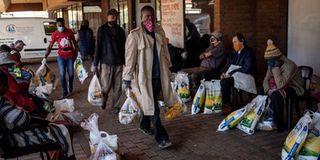South Africa braces for second wave of Covid-19 infections

Volunteers distribute food parcels in Brapkan, Ekurhuleni, on July 6, 2020.
South Africa is bracing for a second ‘wave’ of Covid-19 infections as community transmissions begin to peak again.
Health minister Zwele Mkhize and his wife are among high-profile figures to have recently tested positive, underlining the continuing threat of the pandemic to all citizens. With some 716,000 cases and 18,968 deaths, South Africa remains the hardest hit country on the continent and 12th in the world, just behind the United Kingdom.
Overnight new cases are back between 1,000 and over 2,000, with deaths down from the highs of two months ago, but likely to climb as infections grow.
The impending second wave is due to the virus having new opportunities since South Africa entered a much more open economy a few weeks ago.
New infections are occurring in all groups and sectors of society and in remote rural areas, meaning the next wave is likely to be much more generally distributed than the first, which initially hit urban centres and did so consecutively.
The second wave will therefore probably present a much more daunting challenge in terms of treatment capacity than the first. Cape Town has already been identified as the second wave’s first major hotspot, repeating what happened in the first round of infections, though this time the background community incidence rate is far higher.
Dr Mkhize and his wife coming down with the virus recently highlighted the ongoing crisis, though the minister attempted an upbeat note. The minister said that while the nation had reported fewer than expected cases following the reopening of the economy, it was probable that South Africa would follow other countries in experiencing a second wave.
There was no reason that South Africa could expect to avoid what had happened in Europe and the US, where the second wave is now evident, he added. While a second wave of infections is certain, it is likely to be less deadly than the first, according to the Actuarial Society of South Africa (ASSA).
Lusani Mulaudzi, healthcare actuary and president of ASSA, said the organisation had recently updated its modelling of the virus in the country based on new information, which, while incomplete with respect to actual deaths versus recorded deaths, was more reflective of the pandemic’s real impacts.
According to Mr Mulaudzi, modelling the mechanics of Covid-19 remains complex as the science of the virus and disease is still evolving and data is incomplete and inconsistent, adding that even “hard data”, such as accurate mortality rates, were “incomplete”.
Beyond that, however, there seemed no escaping a second wave. One key model update was in the assumptions around the levels of susceptibility to Covid, which initially was believed to be equally risky for all, but turns out to be variable, depending on different contact conditions and infection rates.
“The reality is that not everyone comes into contact with the same number of people, and not everyone is equally susceptible to becoming ill after coming into contact with the virus,” he said.
The updated model uses published death data, but acknowledges that the official death count is most likely significantly understated. Mr Mulaudzi points out that the true number of deaths probably lies between the official figures and the South Africa Medical Research Council reported “excess deaths”, put at 15,499 as of September 15, for a potential total of over 34,800 Covid dead.
The actuarial body has produced various modelled outcomes depending on factors such as susceptibility and exposure to the virus with, according to one, as many as 27,000 known deaths by the year end – an infection fatality rate of 0.28 per cent and a mortality, per million lives, of 481.
South Africa’s death rate per million people is 249, compared to 570 in the US and 612 in the UK, with Belgium recording 855 deaths per million, among the highest for any population of over a million people.
Showing the still highly unpredictable nature of the Covid virus, another scenario assumes that a large proportion (60 percent) of the population is not susceptible to the virus, but that only 35 percent of those who do get infected are asymptomatic.
In this scenario, the number of deaths by the end of the year here could be 50,000, with a comparatively high infection fatality rate of 0.49 percent and a mortality per million lives of 876, among the highest in the world.




